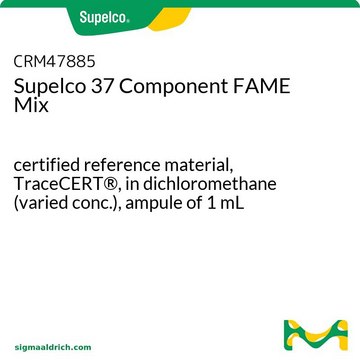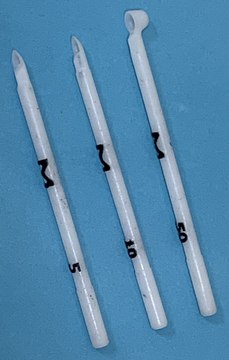925470
Calibrated ChemBeads Scoop
Sign Into View Organizational & Contract Pricing
Select a Size
Change View
20 MG
₩504,658
About This Item
UNSPSC Code:
12352101
NACRES:
NA.52
Recommended Products
Quality Level
Related Categories
1 of 4
This Item | BAH369020000 | HS120858 | HS120852 |
|---|---|---|---|
| Quality Level 100 | Quality Level - | Quality Level - | Quality Level - |
General description
Calibrated ChemBeads scoops allow you to weigh ChemBeads products volumetrically. These scoops have been designed to consistently deliver the calibrated amount of ChemBeads quickly and efficiently. The scoops are made of a chemical resistant plastic, acrylonitrile butadiene styrene, and can be reused multiple times, however they should not be cleaned with strong solvents.
There are three sizes of Calibrated ChemBeads Scoops available or a kit containing a set of all three. The sizes are outlined below with Catalog Number and Calibrated Weight:
925470-5MG 5 milligrams
925470-10MG 10 milligrams
925470-50MG 50 milligrams
925470-1SET one of each scoop calibrated to deliver 5, 10, or 50 milligrams
ChemBeads are chemical coated glass beads. ChemBeads offer improved flowability and chemical uniformity perfect for automated solid dispensing and high-throughput experimentation. The method of creating ChemBeads uses no other chemicals or surfactants allowing the user to accurately dispense sub-milligram amounts of chemical.
Learn more about ChemBeads products
There are three sizes of Calibrated ChemBeads Scoops available or a kit containing a set of all three. The sizes are outlined below with Catalog Number and Calibrated Weight:
925470-5MG 5 milligrams
925470-10MG 10 milligrams
925470-50MG 50 milligrams
925470-1SET one of each scoop calibrated to deliver 5, 10, or 50 milligrams
ChemBeads are chemical coated glass beads. ChemBeads offer improved flowability and chemical uniformity perfect for automated solid dispensing and high-throughput experimentation. The method of creating ChemBeads uses no other chemicals or surfactants allowing the user to accurately dispense sub-milligram amounts of chemical.
Learn more about ChemBeads products
Other Notes
High-Throughput Reaction Screening with Nanomoles of Solid Reagents Coated on Glass Beads
Versatile Methods to Dispense Sub-Milligram Quantities of Solids using Chemical Coated Beads for High-Throughput Experimentation
ChemBead Enabled High-Throughput Cross-Electrophile Coupling Reveals a New Complementary Ligand</A
Versatile Methods to Dispense Sub-Milligram Quantities of Solids using Chemical Coated Beads for High-Throughput Experimentation
ChemBead Enabled High-Throughput Cross-Electrophile Coupling Reveals a New Complementary Ligand</A
Choose from one of the most recent versions:
Certificates of Analysis (COA)
Lot/Batch Number
It looks like we've run into a problem, but you can still download Certificates of Analysis from our Documents section.
If you need assistance, please contact Customer Support
Already Own This Product?
Find documentation for the products that you have recently purchased in the Document Library.
Customers Also Viewed
Kulp K et al.
Batters and Breadings in Food Processing, (2) (2016)
Clare M Reynolds et al.
The Journal of nutritional biochemistry, 24(2), 401-411 (2012-05-26)
Conjugated linoleic acid (CLA) is found naturally in meat and dairy products, and represents a potential therapeutic functional nutrient. However, given the discrepancies in isomer composition and concentration, controversy surrounds its proposed antidiabetic, antiobesity effects. This study focused on the
Eva Katharina Richter et al.
Lipids, 47(2), 161-169 (2011-08-13)
This study explores the potential use of stable carbon isotope ratios (δ(13)C) of single fatty acids (FA) as tracers for the transformation of FA from diet to milk, with focus on the metabolic origin of c9,t11-18:2. For this purpose, dairy
Sanjay Basak et al.
Biochimica et biophysica acta, 1831(4), 834-843 (2013-01-29)
A number of studies have been carried out to examine the biological function of conjugated linoleic acid (CLA) and its potential health benefits. However, not much is known about how CLA isomers mediate their effect on angiogenesis and vascularization during
Jason R Deguire et al.
Nutrition research (New York, N.Y.), 32(12), 911-920 (2012-12-19)
The relationships between conjugated linoleic acid (CLA) status, bone, body composition, and the effect of CLA on calciotropic hormones are unclear. A cross-sectional study was designed to examine the association between c9, t11 CLA status in erythrocyte membranes (RBC) and
Our team of scientists has experience in all areas of research including Life Science, Material Science, Chemical Synthesis, Chromatography, Analytical and many others.
Contact Technical Service










